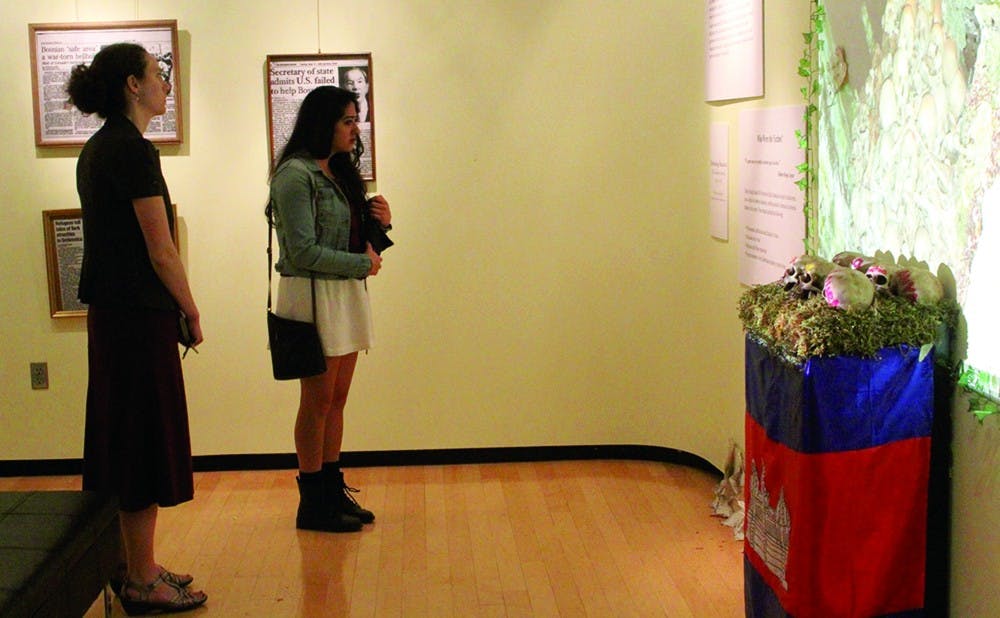The Coalition for Preserving Memory and Duke University Union collaborated to present a multimedia exhibit as part of Genocide Remembrance Week.
The six main walls of the exhibit consist of photos of moments of genocide throughout the world. The exhibit serves as a means to facilitate discussion, said exhibition curator Josephine Ramseyer, a sophomore. The Armenian, Darfur, Cambodian, Rwandan and Bosnian Genocides as well as the Holocaust were the primary features of the exhibit.
“My vision was two things,” said Ramseyer. “One, to bring the discussion of genocide to campus through student art and their perspectives, and two, to question the term genocide itself because it is so politicized, so contested and such a big word to label something.”
Sophomore Eliza Meredith, CPM president and a collaborator on the exhibit, said the point was to grapple with the heart of the issue surrounding genocide, but that it is hard to do so because genocide can mean so many things.
“It was great to bring together so many people and to interpret these events through their eyes.” Meredith said. “Genocide affects us all but there are different ways to interpret the past and reconcile these awful moments in history besides the naming ceremony.”
Part of the exhibit was dedicated to commemorating the lives of those belonging to the LGBT community who were persecuted during the Holocaust.
“Some people might feel like they already know about the Holocaust, but this is a different take on it,” said sophomore Fiona McCrossin. “It is very important to educate about LGBT persecution in terms of the perspective of non-Jews and particularly important that people understand the gravity of the situation.”
“This exhibit offers a new perspective because we are not giving people numbers or facts, but having people tell their own stories,” said sophomore Lauren Silk. “Having photos saying how people felt is a great opportunity to tell their struggle.”
Junior Adesuwa Giwa-Osagie, a contributor to the creation of the wall commemorating the Rwandan genocide, said part of the approach of her part of the exhibit was to re-investigate the master narrative of history.
“Rwanda’s parliament, out of all countries, contains the largest percentage of women,” said Giwa-Osagie. “This information should offer a new perspective to those investigating the genocide and its affects.”
Junior Yohana Zecarias, another contributor to the Rwandan wall, added that part of the goal of the exhibition is to try to move past the genocide.
“It is important to acknowledge the present and not dwell in the past,” she said. “It was a devastating event for both men and women but it is important to acknowledge that we can move past that and not maintain certain stereotypes.”
Junior Ananya Zutshi, a contributor for the Kashmir exhibit, said she has been to Kashmir once but her family will not let her return due to safety concerns. She added that in technical terms, the events that occurred in Kashmir are not considered a genocide.
“I have been raised to know, however, that even though the numbers are smaller and it is not nationally recognized as a genocide, that it is still important, still happening and needs to be recognized,” said Zutshi. “It raises the question of what is genocide? Does it depend on the type of killing, or the number of deaths? To me genocide is a systematic slaughtering of people—it is using terror and murder for means of dictatorship and it happens at all different scales. You have to think about it. You can’t forget, because it will happen again.”
Sophomore Risa Pieters, the main contributor for the Cambodia exhibit, displayed personal photographs of a cave filled with the remains of human skeletons.
“It is really daunting that they are the real skulls,”w she said. “You can feel how recent it is. To me it is a very recent genocide as I have friends and family who are directly affected,” she said. “If you walk down the streets, you can see that there is a visible generation missing.”
“I think the representation of different conflicts through different multimedia experiences corresponds quite appropriately with the diversity of genocide and the sense of individual disparity that is unified in one gallery,” said sophomore Justin Sandulli. “It is an incredible collection that is unfolded under the wide spectrum of genocide.”
Sophomore Alissa Anderegg, a student who visited the gallery, said the exhibit put things into perspective.
“We at Duke are so blessed to be in such a safe and comforting environment where education is valued and such a luxury,” she said. “It makes me cherish and appreciate the opportunities we have here.”Get The Chronicle straight to your inbox
Signup for our weekly newsletter. Cancel at any time.

